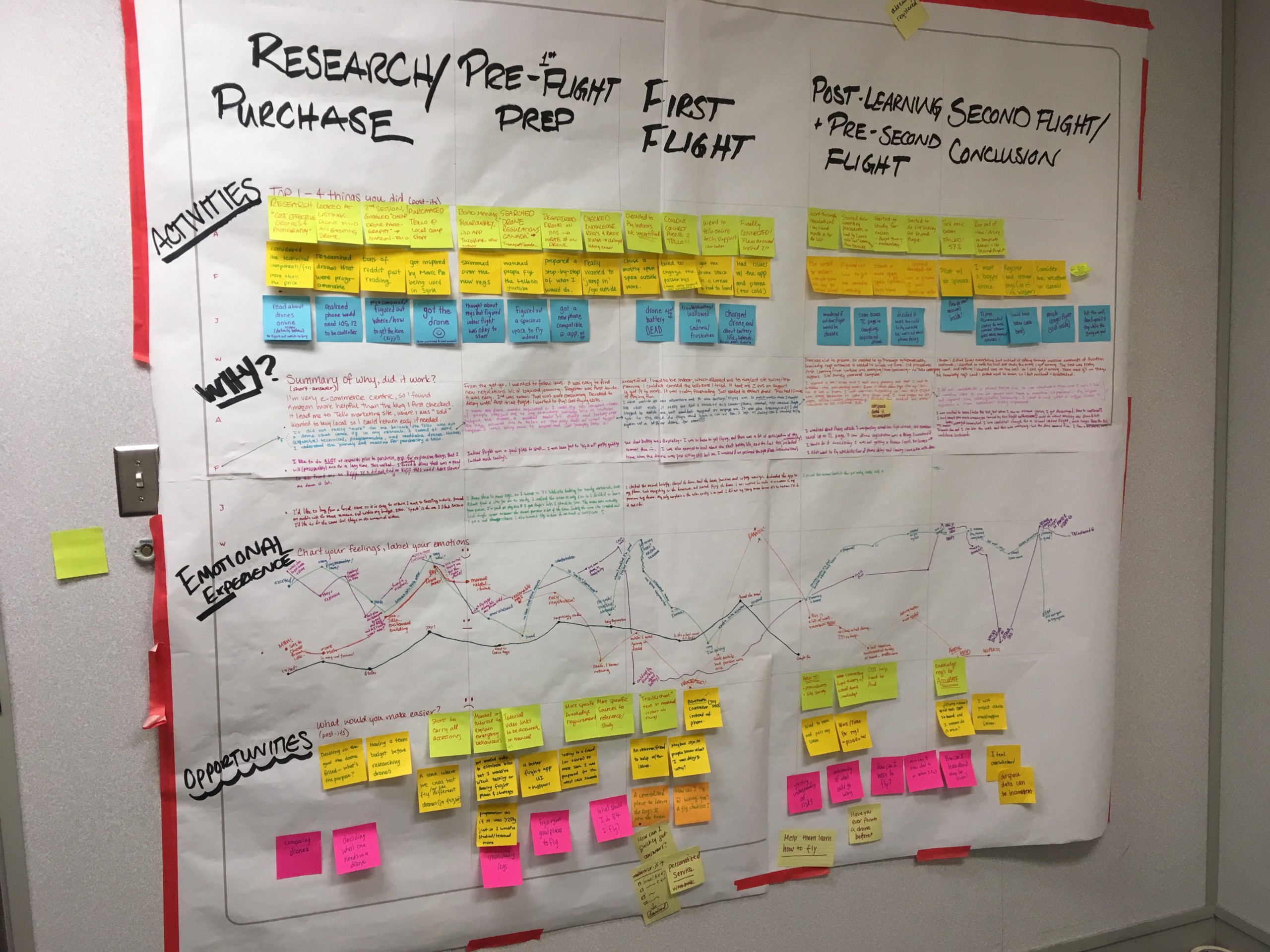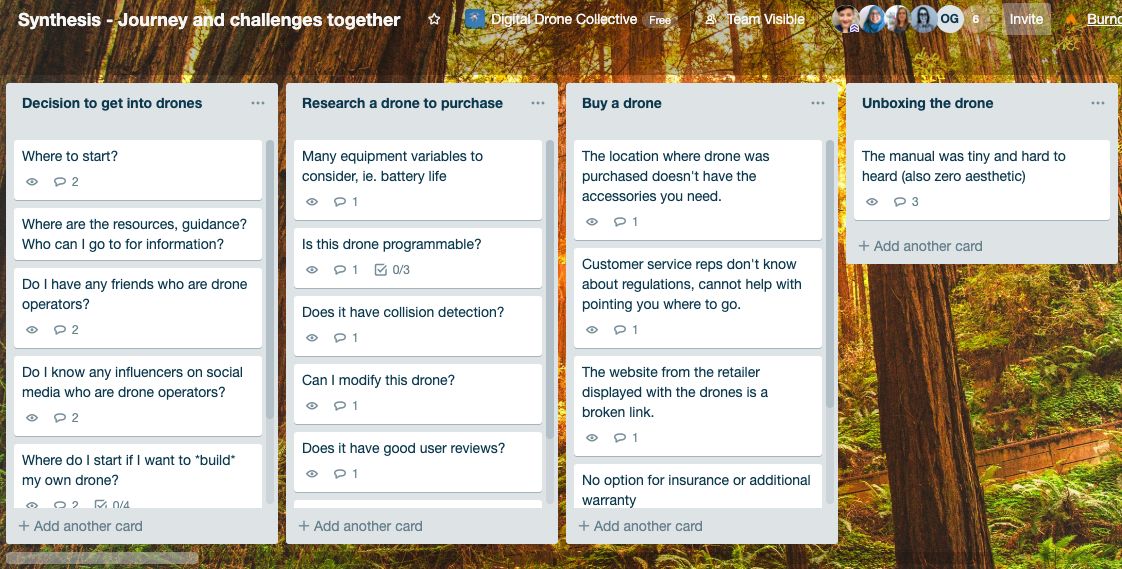Immersion— A winning tactic for empathy and journey mapping
A user research tactic used on our project with Transport Canada.
Introduction
I had never heard of “immersion” before this project. It came from a very specific need on our project that I predict is common in government regulation/service delivery. Now that we’ve completed it, I have some reflections about how this tactic can be useful for public servants. It builds strong empathy and helps uncover long and challenging user journeys that might be hard to capture otherwise. This blog explains why we needed an immersion study, how we did it, and how it might be useful for your team.
Transport Canada won a bid for a Code for Canada Fellowship team to support the regulation delivery for drones (project intro here). Our mission is to focus on recreational/hobby drone operators and support their compliance with the regulations. In other words, these aerial picture-takers now need to share the responsibility of being in the skies, like pilots. Come June 1st they will need to register their drones, pass a knowledge exam, and follow standard aviation practices. For the recreational operators, it’s a whole new world. (User interview findings here.)
Predicting future problems
The publishing of the new regulations happened 2 months after our project started. We were not allowed to know the contents before public release. Because of the nature of these regulations, enforcement is set for 6 months after public release. That brings us to June 1st, 2 months before the completion of our contract. Thus, knowing how recreational drone pilots navigate the new regulations is going to be unknown until after June 1st. If we wanted to solve a real problem for this group of drone operators, we were going to need to be creative. Although the current problems might be future problems, we couldn’t ignore how different the new regulations are to the current ones.
Pre-requisites
The Transport team did not have anything tangible to tie together the efforts of program and service delivery. If we were to learn where to place a product, we had to map the existing and current efforts, and the user journey through those. Mapping the current effort was more difficult than anticipated; the Transport team has a lot of areas to build for. We identified missing pieces alongside our Transport team. They matched the suggestions they made of products we could build for them. But if we only placed effort on one program area, we could miss the potential transferability of support in many areas. Or miss solving for a more pressing problem.
Now that we had our internal map of delivery, we needed the user journey. But as I mentioned earlier, we had no users to ask about their experience. So we became them.
I was leading the team in research, and was able to direct this study using all core technical team members:
- Jen Payne, Product Manager
- Fatima Khalid, Solution Architect, Lead Developer
- WeiGuang Xiao, Developer
Here’s the video we made to introduce Immersion to our stakeholders.

Immersion — core researchers to become recreational drone pilots themselves.
This is typically not ideal in research. The saying goes, “You are not your user.” As technology professionals, we are often too biased to emulate our user and make good user-centred decisions. But our target user group is quite large in demographics and usage. Recreational drone users could be anyone but are also likely to be technology and engineering enthusiasts like us. We determined the value we could achieve from becoming our user could outweigh the bias. Of course, this need for mapping the end-to-end experience is only one piece of what would influence our problem definition. It did not replace user interviews but supplemented them.
Immersion Study Framework
Step 1: Determining Journey Phases
We mapped out the major phases within the user’s journey to align our explorations. The phases could be done in different orders or omitted with reason.
- Research — pre-purchase
- Purchase
- Unboxing
- Learning — pre-flight
- Pre-flight Preparation — first flight
- First flight
- Learning — post-flight
- Successful flight — flying in accordance with new regulations and not damaging anyone or anything.
Step 2: Diary Entry Design
As we go through the phases of the end-to-end experience of flying a drone under the new regulations, we captured in diary entries:
- What we did
- Why we did it
- How it went
- How it felt
- Why we think we’re ready to move on to the next phase
- Perceived next steps
We captured these questions with a combination of video and written reflection.
Step 3: Working around constraints — purchasing and time
For the sake of our budget, we had to augment the experience of purchasing. Instead of buying 4 drones, we would buy 1 and share. We determined who would get to buy their desired drone as a group. We decided to buy the cheapest drone that met all our unique needs. Here’s the short video of our drone purchase.
We also had to schedule time with the drone for the learning phases. We came up with a rotating schedule. From this, we determined the quickest possible timeline for completing the study. 3 weeks would be the time for us each to walk through the process.
Mapping the journey
At the end of our three weeks, we charted our work on an experience map pictured below. At the end of sharing our journeys with each other, we could see these aspects:
- the steps in the journey,
- the emotional highs and lows,
- how far each of us could go in 3 weeks,
- how compliant we felt we were in that time.
We discovered that the process was much more intensive than we thought. None of us completed the entire journey to compliance. Regardless of how far we went, none of us felt that we were fully compliant.

Outcome
Having the new journey mapped with it’s problems allowed us to contextualize the current problems we found in user interviews. We used Trello to map the high-level steps we found, and then the problems (both existing and predicted) that lie within each step. Now that the data was visible, we could all take a stab at what we thought were the underlying challenges in the regulation delivery. By understanding these underlying problems, we could create a solution that scales beyond one regulation effort. Now we could create a solution that would support the entire onboarding process.

Reflections — what worked and what didn’t
Immersion got us to where we needed to go, but, we had to face the reality that none of us were able to complete the entire journey in the time we had allotted. This meant that when we decided on the site survey as a place to start prototyping, we had to do more research. I would have liked to foresee the potential for not completing the entire journey. That way I could communicate contingency plans for further research. Without that framing, this failure might feel like a real failure, when it is an important finding onto itself.
Being too frugal also hindered the study. We bought a drone that didn’t end up meeting the weight requirements for the new regulations to save some money. I communicated to the team to pretend that it was regulation weight, but the message was lost on one of our researchers. They went through the journey not believing that they had to follow the regulations. In the end, it was valuable to see what aspects of the regulations someone would interact with who was not intending to follow them. But there were some frustrations about the miscommunication. When biases or adaptations come up, it’s important to document them and ensure everyone understands what is needed to minimize the effects on the rest of the study.
Using Trello allowed for us all to take part in synthesis, coming up with our own findings of underlying problems. We were able to see the commonalities between all of our findings and prioritize them. It also made it easier for our stakeholders to see what we were doing, and how this made the problem space clear for us.
Going forward with immersion in government
This tool was effective for these objectives:
- Gaining empathy and a lived understanding of the needs of the end-user, and where to best apply given limited resources
- The journey of completing a long process that might be hard for a user to continuously document
- Knowing where to further research on more challenging process areas
- Low cost, quick to get going, and tangible results
In government, regulation delivery is likely broad with a large scope and several user groups, making user research a tall order. Immersion can set the journey and priorities in a user-focused delivery effort. It avoids recruitment, and the effort needed to onboard users in a long, arduous study, as well as compensating them for a large amount of effort. For this study, I would have offered participants $150-$200. More importantly, the empathy gained is immeasurably valuable. A team might not be able to consider user experience in every area, but knowing how the entire journey feels can help prioritize.
If you have further questions about immersion or our project, don’t hesitate to reach out! @andeepittmanux on twitter, or email me here.


